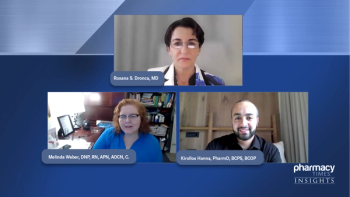
Overview of Prescription Discount Programs
Lisa King, RPh, provides an overview of Prescription Discount Programs including purpose, how it works, differences from other assistance programs, and benefits.
Episodes in this series

Suzanne Soliman, PharmD, BCMAS: Hello and welcome to this Pharmacy Times® Insights discussion, “Optimizing Patient Outcomes with Prescription Discount Programs.” I am Dr Suzanne Soliman, founder of the Pharmacist Moms Group and chief academic officer with the Accreditation Council for Medical Affairs. Join me today in this virtual discussion with my colleague Lisa King, RPh, clinical staff pharmacist at Nexus Patient Services and founder of The Fulfilled Pharmacist. Today, we are going to discuss resources available to patients and pharmacists that can help optimize patient health care outcomes—for example, increasing drug therapy affordability. We will share insights into how to best utilize these options. Let's get started.
I just wanted to start out by asking about prescription discount programs. How do they work? Discuss what they are, and some of the basics of them.
Lisa King, RPh: Prescription discount programs were created to help patients have affordability to their medication and then access, which helps with adherence. It helps lower prescription costs for patients, whether they have prescription insurance or not. Many of the patients using these cards may be paying in cash; they do not have another prescription program through their health insurance, but these cards are available to patients, whether they have health insurance or not.
Suzanne Soliman, PharmD, BCMAS:How are they different from other patient assistance programs, manufacturer coupons, or other programs?
Lisa King, RPh: Co-pay cards are often dispersed through the manufacturer. The manufacturer will offer a discount to the patient that can be coupled along with their prescription insurance or used on its own. Sometimes they will have a $0 co-pay for their prescription, but these prescription discount programs are completely different. They are used on their own for patients, as I said, who may have insurance or may not have insurance. It is a discount that is offered through the pharmacy where the prescription discount program will have a negotiated rate for the pharmacy to have a lower cost to the patient. It is strictly through the pharmacy and through the prescription discount program, in order to negotiate a lower price of that prescription and then pass it on to the patient. This helps with patient affordability for the medication, especially for patients who do not have prescription insurance through their health provider.
Suzanne Soliman, PharmD, BCMAS: Can they be used at all pharmacies? Is it just certain pharmacies? Are there chain pharmacies? I know that some of them that I have seen are only accepted at certain pharmacies, but talk to me more about where they are accepted.
Lisa King, RPh: Mostly, they are accepted through several pharmacies. There are a lot of options for patients and they should look around for the best price, but you can usually find a prescription discount program available at most pharmacies. Some will have only certain pharmacies that they have negotiated with, but others, you can use at all pharmacies. It provides great savings for the patient, especially if they have high co-pays or do not have any health insurance.
Suzanne Soliman, PharmD, BCMAS:How does the savings work for patients?
Lisa King, RPh: Through that negotiated rate, they get the lower price at the pharmacy. Often, patients will wonder if this is legitimate. As a pharmacist, that is probably the biggest thing that I see: they think, “How can this possibly be true? It sounds too good to be true. Why would the pharmacy want to even do this?” It helps the pharmacy as well, because through that discounted rate, the patient is able to fill their prescription. Prescriptions may be so expensive that the patient would not even be filling that prescription anyway. The pharmacy is still able to make some money through that discounted rate; they have great patient services, provide great customer service by using that card, and have that patient loyalty so the patient may then keep coming back to that pharmacy. They may purchase other things inside that pharmacy on that trip or on future trips as well. It is something that is beneficial for the pharmacy and the patient; it is a wonderful thing and not too good to be true.
Suzanne Soliman, PharmD, BCMAS:I think that is the key; it is not too good to be true. It’s legitimate and they work.
Transcript edited for clarity.
Newsletter
Stay informed on drug updates, treatment guidelines, and pharmacy practice trends—subscribe to Pharmacy Times for weekly clinical insights.
















































































































































































































